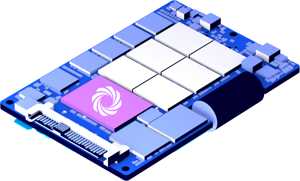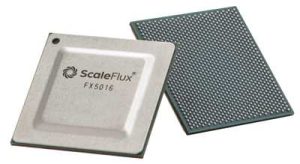ScaleFlux Powers Future of Edge Computing: Efficiency Gains Amid Data Explosion
Emergence of SoC ASICs unlocked new frontier of edge computing possibilities
This is a Press Release edited by StorageNewsletter.com on September 6, 2024 at 2:01 pmBy processing data closer to its source, edge computing offers efficiency gains and has already seen rapid growth and widespread adoption.
However, much of its potential hinges on advancements in efficiency, with industry providers like ScaleFlux, Inc. playing a key role in shaping the future of this technology. The company‘s computational storage solutions have had a traceable impact on changing edge computing, underscoring the value of storage considerations when organizations choose to pivot to the edge.
As businesses WW increasingly digitize every aspect of their operations, the amount of data being generated, processed, and consumed is projected to hit an unprecedented 180 billion TB by 2025. (1) This massive influx of data threatens to overwhelm both on-premises and cloud systems, resulting in network congestion, soaring energy costs, and expensive infrastructure upgrades. Edge computing has quickly emerged as a response to this data deluge.
“As more data is generated, relying solely on centralized computing can create delays and inefficiencies. Edge computing addresses this by distributing processing closer to where data is generated, which helps in managing the load and ensuring quicker responses,” explains JB Baker, VP.
Such is the pace of adaption that 75% of enterprise-generated data will be created and processed at the edge by 2025. (2) A recent forecast shows that global spending on edge computing is expected to reach $232 billion by the end of the year – an increase of 15% over 2023. (3) But even as companies start to heavily invest in edge computing processing capabilities, they must not lose sight of the critical role that storage plays in this approach.
Edge computing: how it works, and how it will evolve
Edge computing brings computing resources like servers, storage, and networking closer to data sources. This approach enables data to be processed locally, reducing the amount of data transmitted to data centers by 60% to 90%. (4) Only specific data types, such as processed results, anomalous data, or complex data requiring further analysis are sent back from the frontiers.
“The future of edge computing is deeply intertwined with innovations in storage and memory,” says Baker, highlighting how advancements in computational storage are crucial for enhancing efficiency and scalability in edge computing.
Because of this, edge computers confer numerous advantages to businesses:
- Low latency: Because data is processed in a local device, near-instantaneous responses are possible. This feature is crucial for applications like industrial automation or even self-driving vehicles.
- Cost efficiency: Lower bandwidth usage directly translates to lower data transfer fees – up to 70% less by some estimations. (5)
- System resilience: As most of the processing tasks are performed locally, reliance on data centers is lower. If connectivity is lost in the event of a network outage or a cyberattack, operations can continue uninterrupted. Medical devices such as remote patient monitoring systems increasingly leverage edge computing to ensure continuous local processing of patient data, which can be critical during network disruptions.
- Scalability and flexibility: Organizations can adjust their local data processing capabilities by adding or remove edge devices as needed. The retail industry is expected to be a prime beneficiary, with retailers deploying additional edge computing resources in stores during peak shopping seasons and removing them during slower periods.
While the concept of edge computing has been around for decades, it has only gained prominence recently thanks to a convergence of timely technological developments. A major factor is the need for extremely fast networks to support a vast number of connected devices. Such a network infrastructure only became widely accessible with the arrival of 5G in 2019.
Another obstacle to earlier edge computing adoption was the limitations of storage devices. Compared to today’s standards, early HDDs and SSDs offered relatively small storage and slower RW speeds. Moreover, being connected to CPUs in data centers or servers prevented data from being processed on the edge. The rise of computational storage in the early 2020s was instrumental in advancing edge computing.
“The future of edge computing is deeply intertwined with innovations in storage and memory,” states Baker. “As storage and memory solutions evolve, so too will edge computing.”
 Computational storage: Backbone of edge computing
Computational storage: Backbone of edge computing
A quick rundown of computational storage should make it abundantly clear as to why it is a cornerstone of edge computing. Conceptually, computational storage means combining embedded processing capabilities with a high data density (i.e., storage capacity per node) storage device. Unlike traditional storage solutions, computational storage takes on functions traditionally performed by the CPU. This enables the use of lower cost and lower power CPUs and distributes heat generation to aid in managing thermal dissipation.
Advancements in computational storage have consistently pushed the boundaries of edge computing, reinforcing the former’s foundational role. For example, computational storage has been typically enabled by a reprogrammable integrated circuit called a Field-Programmable Gate Array (FPGA), which allows for data filtering, transformation, analytics, compression, and encryption on the storage device.
 However, industry providers like ScaleFlux have recently demonstrated that using a custom-designed integrated circuit (SoC ASIC) can achieve these functions more cost-effectively, with lower power consumption, and with reduced software and hardware requirements.
However, industry providers like ScaleFlux have recently demonstrated that using a custom-designed integrated circuit (SoC ASIC) can achieve these functions more cost-effectively, with lower power consumption, and with reduced software and hardware requirements.
The emergence of SoC ASICs unlocked a new frontier of edge computing possibilities. Their unique combination of high performance, low power consumption, and affordability makes them a fit for the limited space, power, and cost budgets for edge servers.
The healthcare industry was also quick to pivot from FPGA to SoC ASIC; the latter’s longer battery life makes it a superior choice for remote monitoring devices, and it is easier to integrate with wearable devices as well.
In short, the expansion of edge computing is very much predicated on progress and capabilities of computational storage, as illustrated from the shift from FPGA to SoC ASIC technology. The implication is that efforts to implement edge computing for digital transformation must pay special care to the computational storage technology that underpins it. Choosing the right technology is crucial, as it affects not only the performance and efficiency of edge applications but also their scalability and reliability.
“The computational storage directly addresses several of the challenges and constraints faced in edge computing,” concludes Baker. “It’s crucial to look beyond ‘component-to-component’ comparisons using traditional benchmarks and to look at the impact components can have at the system level to influence the features and capabilities of the entire solution.”
(1) Valkhof, Bart, et al. Data volume is soaring. Here’s how the ICT sector can sustainably handle the surge. World Economic Forum. Accessed August 14, 2024.
(2) Singh, Raghubir, Sukhpal Singh Gill. Edge AI: A Survey. ScienceDirect,. Accessed August 14 ,2024.
(3) Violino, Bob. Computing and Storage Are Moving to the Edge, and IT Needs to Be Ready. CNBC, June 11, 2024.
(4) ObjectBox. Why do we need Edge Computing for a sustainable future? Accessed August 15, 2024.
(5) IoT.nxt. The Future of AI is at the Edge. Accessed August 15, 2024.















 Subscribe to our free daily newsletter
Subscribe to our free daily newsletter

